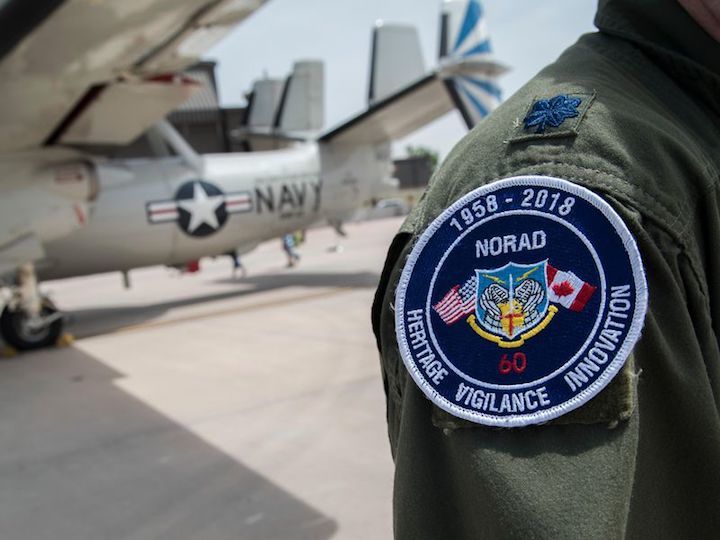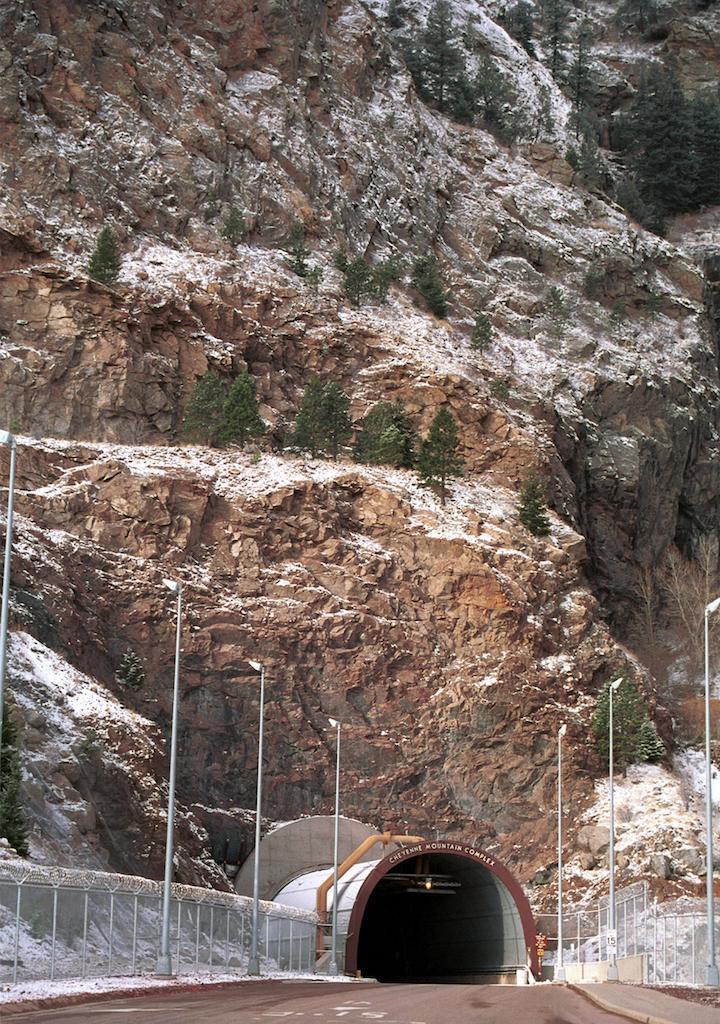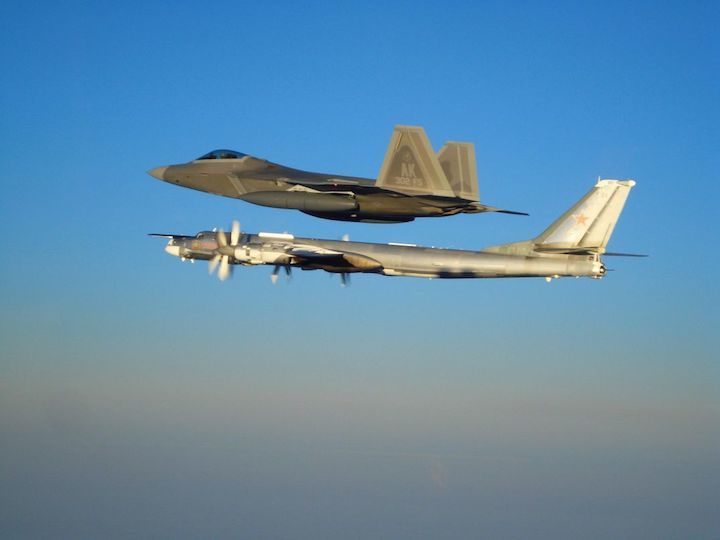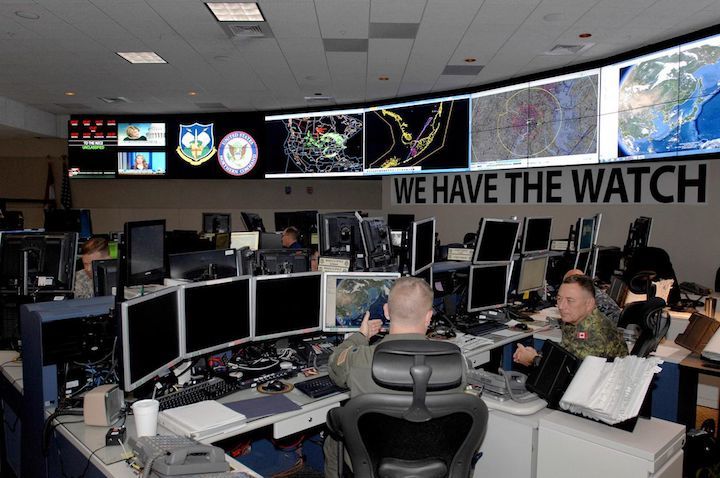4.10.2018

The North American Aerospace Defense Command, a stalwart of the cold war, celebrates its 60th anniversary this year. (USAF/Staff Sgt. Emily Kenney)
About halfway through the tunnel, our bus driver stops beside two steel blast doors, each weighing 25 tons and measuring three feet thick. I’m traveling this frigid January morning into the Cheyenne Mountain Complex with Steve Rose, the facility’s deputy director, who greeted me in the parking lot with an earnest handshake. Rose is escorting me into the historic military bunker burrowed deep into the Rocky Mountain foothills, seven miles southwest of downtown Colorado Springs. “The mountain,” as the complex is known colloquially, is the alternate command center for the North American Aerospace Defense Command (NORAD), which celebrates its 60th anniversary this year.
Since 2006, NORAD’s primary operations have been based at nearby Peterson Air Force Base (because the agency had outgrown the space available inside Cheyenne Mountain). But in the event of an imminent nuclear attack, NORAD personnel would evacuate to the command facility inside the mountain, where 2,500 feet of granite would shield them from impending Armageddon.
Cheyenne Mountain sits 9,570 feet above sea level. Rose and I are on a shuttle nicknamed the “In-and-Out Bus,” which transported us through a horseshoe-shape, 1.2-mile-long entrance tunnel—the north portal arch—situated 2,000 feet below the mountain’s summit. Rose is chatty, full of factoids and trivia. He rattles off a few Hollywood thrillers that have staged scenes at Cheyenne Mountain: Interstellar, Dr. Strangelove, the television series “Stargate SG-1” and, most relevantly, WarGames (much of the 1983 film, about a computer simulation that nearly triggers a nuclear war, takes place in a re-imagined NORAD command center). Above ground, the mountain’s dense woodlands teem with critters. “We have three black bears, 70 wild turkeys, two mountain lions, and an occasional fox,” says Rose.

NORAD’s command facility is famously housed inside a Colorado mountain. (NARA)At the blast doors, we disembark and enter into a foyer, which is empty except for a stout plastic Christmas tree festooned with silver baubles and miniature red stockings. During peacetime, both doors remain open. But they’re intentionally hinged outward, notes Rose. Should a nuclear strike occur from, say, North Korea, the explosive blast-wave would barrel through the open-ended tunnel and slam the doors shut, ensuring that whoever is inside survives.
Beyond the foyer and through the second blast door, I find myself in a large grotto where wood pallets are stacked with sleeping cots, non-perishable rations known as MREs (meal, ready to eat), and a sundry of other military supplies. While I wonder what it would be like to reside here for months while a nuclear holocaust rages outside, Rose informs me, “We have everything we need for the duration of a war.”
The Cheyenne Mountain Complex, which opened in 1966, took six years to build and cost $142 million (about $1 billion in today’s valuation). When the agreement between the U.S. and Canadian governments to combine air defenses against a Soviet threat was made formal on May 12, 1958, the joint command was initially located at Ent Air Force Base in Colorado Springs. (Ent closed in 1976, and is now home to the U.S. Olympic Training Center.) Today NORAD shares the mountain with the U.S. Northern Command (NORTHCOM) and 10 other tenants whose designation and purpose are classified.
It took five months to arrange my visit—security measures place strict limits on who gets inside. But finally here, what I notice first is the air. It’s warm and refreshingly moist, almost tropical. “This is probably the cleanest air in the world,” says Rose. The ventilation system is outfitted with dozens of nuclear, biological, and chemical filters along with special blast valves, all of which can sustain a safe, breathable atmosphere even if toxic fallout rains down above.
Much has changed in the six decades since U.S. and Canadian military forces began their collaborative guardianship. At first, NORAD’s role focused on monitoring North American airspace for possible Soviet incursions. The great fear was that nuclear-armed, long-range bombers would sneak over the Arctic. By the late 1960s, intercontinental ballistic missile (ICBM) technology had emerged, and NORAD turned its attention toward space. (Still, the “A” in its name stood for “Air” until it changed to “Aerospace” in 1981.) After the September 11, 2001 attacks, NORAD expanded its purview to track potential intruders originating inside the United States and Canada. Today, with the increased threat of terrorism and cyber warfare, NORAD is keeping tabs on nearly everything—from reports of unruly passengers on commercial airline flights to suspicious vessels meandering from the Caribbean toward American shores.
**********
Cheyenne Mountain houses 13 three-story buildings and two two-story buildings on five acres inside a cavern created by dislodging nearly 700,000 tons of granite with 1.5 million tons of dynamite. The buildings are roomier on the inside than one would expect. They’re also a bit humdrum, with drab, whitewashed hallways and glaring overhead lights. While the place feels like a sprawling office complex—on any given day there are between 350 and 500 people working here—there are reminders that I’m entombed in a bunker capable of withstanding a 30-kiloton nuclear blast.
As we enter Building One, Rose draws my attention to its exterior walls, welded together from solid three-eighths-inch-thick Navy-grade steel. I rap my knuckle on the surface, and it clanks like the hull of a container ship. “My job is being a captain of this aircraft carrier underground,” jokes Rose, adding that marine engineering inspired much of the interior layout and design. The steel also has a vital function: It helps deflect the powerful electromagnetic pulse (EMP) that emanates from a nuclear detonation, which fries computer microprocessors. A more recent menace is the so-called “EMP bomb,” which can cripple electronics across entire city blocks. “That is the threat du jour,” says Rose. “And this is the best protection against EMP anywhere in the world—it’s one reason that we’re still active here today.”

In November 2007, NORAD dispatched an F-22 assigned to the 302nd Fighter Squadron to intercept a Russian Tupolev Tu-95 bomber flying near Alaska’s coastline. (USAF)
Rose stops on a short gangplank that straddles a gap between adjoining buildings so he can show me their foundation: four-foot-tall white springs aligned in tidy rows. Rose explains that the entire facility rests on 1,311 steel coils, each weighing 1,000 pounds. Their function is to absorb the seismic shock waves that would accompany a nuclear explosion, which can register a magnitude of nearly 6.0 on the Richter scale. “When the mountain is shaking, we want the facility to survive,” says Rose.
As we move through the mountain, I’m glad Rose is leading the way because with no windows or geographical reference points, I’d be hopelessly lost. We poke our heads into the Granite Inn—a Subway restaurant where staff can grab a quick lunch—before reaching the NORAD and NORTHCOM command center. The first thing I see upon stepping inside is a rectangular LED sign that reads, “Unclassified Work in Progress.” It’s there to inform everyone in the room of my presence—to ensure nobody inadvertently says or does anything that would reveal who or what NORAD is tracking at the moment. Not surprisingly, I couldn’t bring my cell phone. In fact, mobile phones—for anyone—are not allowed inside the mountain due to the risk of a security breach.
I’m also not privy to the full capability of the center’s satellite-based sensor technology. The data feed from satellites is normally displayed on seven large overhead monitors. But because of my visit, five have been switched to benign cable programming—CNN, Fox News, and an alpine ski-racing event. Travis Morehen, the Canadian air force colonel who is the NORAD-NORTHCOM command center’s deputy chief, promises me that his team members aren’t chronic channel-surfers.
Except for two screens that display real-time air traffic over the continental United States, I don’t know exactly what they’re monitoring in the command center. But it’s a sure bet that North Korea is getting plenty of attention.
“North Korea has made everything old, new again,” says Brian Laslie, deputy command historian for NORAD and NORTHCOM. That’s evident in something as simple as the command center clocks. Eight of them, arranged horizontally along a low wall, display time zones around the globe—Moscow, Alaska, Pacific, Mountain, Central, Eastern, and Zulu. A new zone was added to the series recently: Korea. What compelled Morehen to include it? “Isn’t that obvious?” he replies. “The [missile] launches from North Korea forced us to reevaluate our procedures—to evolve them—and reaffirmed our mission.”
What most people don’t realize, Morehen points out, is that Canadian military personnel constitute at least a third of NORAD’s staff. “Not many people know that there are so many Canadians in charge of protecting the U.S.,” he says. “There is a very important mission here being done every day to protect both our countries.” NORAD and NORTHCOM (established in 2002, in response to 9/11) bring together 1,700 people from both military and civilian entities, including the Navy, Army, Air Force, Marines, Coast Guard, and Federal Aviation Administration. Says Morehen: “We’ve got many tribes working here together.”
How does Morehen differentiate the roles of NORAD and NORTHCOM? “NORAD assesses, NORTHCOM defends,” he says. For a visual example of how this works, Morehen shows me a computer simulation that tracks a North Korean missile from launch to impact. When the missile ignites its rocket engine, a so-called “overhead persistent infrared sensor” picks up its heat signature, or bloom. I inquire whether these sensors are affixed to satellites. “You said it, not me,” he quips.
As the simulation continues, the system tries to predict where the missile might be headed using a guide called an “infrared threat fan,” which is shaped like a tuning fork. The prongs bracket the most plausible targets based on what military intelligence tells NORAD about the current capabilities of North Korean missile technology. As the simulation plays out, the program homes in on the most vulnerable impact locations. Let’s just say I wouldn’t want to live in Seattle or Hawaii.
Once NORAD has confirmed an airborne or spaceborne missile, NORTHCOM steps in, alerting military commanders and the president, whose whereabouts are tracked 24/7—and who would presumably give the order to take action. How long does this entire process take, from detecting a bloom to informing leaders? The exact duration is yet another closely held secret—“minutes or seconds” is all Morehen will confirm. What he will say, however, is that whatever and wherever a situation exists, the NORAD-NORTHCOM pairing can provide an immediate response: “Whether it’s forest fires, Chinese subs, Russian bombers, North Korean missiles, cyber attacks, or pandemic threats, there is no one we cannot call.” NORTHCOM has simulated each of these scenarios, and the agency does more than 100 training exercises a year. For wildfires and other natural disasters, NORTHCOM would work through civil authorities such as FEMA. Pandemics would go to the Department of Health and Human Services, and for cyber attacks, the National Security Agency would take the lead with NORTHCOM playing a supporting role.
**********
When I rejoin Rose to continue our tour of Cheyenne Mountain, we exit Building One and step into a vast chamber called the “industrial support area,” where the rough-hewn granite interior walls—supported by 115,000 steel “rock bolts” to prevent a cave-in—are now visible. Rose hands me a hardhat to wear. The first stop is the generator area, the mountain’s secondary power supply, which kicks in if public electric utilities are disabled. It contains six eight-cylinder generators—each the size of a locomotive engine—and 1,500 daisy-chained batteries. “They take over for a classified number of minutes until the generators are up and running,” explains Rose.
Approximately 500,000 gallons of diesel are stored in a fuel reservoir carved into the granite. Electricity is the lifeblood of NORAD and NORTHCOM. A major war, EMP bomb, or even a hacker could disable the national power grid. But inside Cheyenne Mountain, at the alternate command center, the lights and computers and essential electronics would whir away for months while the outside world imploded. The power supply is so stable and reliable that the lights inside the mountain haven’t flickered in 15 years, says Rose.

Since 2006, NORAD’s primary command center has been housed at Peterson Air Force Base in Colorado Springs. Personnel there continue the 60-year practice of constant surveillance to protect against old threats and new. (Norad/Mike Kucharek)
Nobody would get thirsty, either. Farther inside the industrial support area, we come to a freshwater pool that’s the length of a football field and 45 feet deep. It, too, was dug out of the granite mountain. As a prank, somebody has set adrift two plastic decoy ducks, which look lifelike in the dim cavern light. Also bobbing on the surface is a rowboat used for maintenance. The pool contains six million gallons of water—about enough for 250 people to drink and wash with for an entire year. Even then, there will never be a drought. By sheer luck, during construction, engineers unearthed a natural spring inside the mountain that produces about 140,000 gallons of water a day.
I meet up with Morehen again later in the afternoon at Peterson Air Force Base, following his morning shift on the mountain. “As threats have evolved, our systems and sensors have been required to evolve,” he says. Four days a week, NORAD and NORTHCOM conduct drills to test how its staff would respond to various incursions. “We do live-fly training,” explains Morehen. This involves a small aircraft entering a region—Alaska, the continental United States, or Canada—that NORAD is responsible for monitoring. The pilot will deactivate the airplane’s identifying transponder and ignore radio communications while attempting to penetrate restricted airspace.
Not everyone inside the command center realizes it’s a drill, and the ruse is what makes the training effective. “When some people go to work that day, they don’t know we’re going to be flying someone against them,” says Morehen. “We will even do a real-world scramble to get fighters to intercept the plane.” If the mock intruder entered U.S. airspace, Air Force fighter jets would respond; Canadian jets are on alert for an incursion into Canada’s airspace.
Russell “Rusty” Mullins, deputy director for the 721st Communications Squadron, has been working at Cheyenne Mountain since 1984. “A typical day doesn’t really exist,” he says. “You might be looking at cyber threats one moment, and then switch to handling an exercise input the next. There are national-level exercises that might have you stay in the mountain for days, including sleepovers.”
The more things change geopolitically, the more things seem to stay the same inside the mountain. “The Soviet Union was replaced with smaller countries with nuclear arsenals,” says Mullins. “We changed our maps of the world and continued our watch. Nothing more, nothing less. There was no room for error back then, and as long as there are people that are determined to harm us, there is no room for error now.”
Today, NORAD and NORTHCOM members work primarily at the command center at Peterson. “But at least once a month we go to Cheyenne Mountain to assure ourselves we can operate up there seamlessly on a moment’s notice,” says Morehen. The Peterson command center looks similar to the one inside Cheyenne Mountain, but it’s much more spacious to accommodate the ballooning staff who are here to handle an abundance of new threats. “The decision during peacetime was to have everyone under one roof,” Rose told me earlier. “You can’t double the size of the command center [in the mountain] because there is granite behind the walls and the ceiling.” (All computing resources, however, still remain at the mountain, where they’re protected and networked to Peterson over fiber-optic cable.)
After Morehen chats with me for 10 minutes, he informs me that I’m going to have to leave the room because a scheduled rocket launch is about to occur and that requires activating the screens that display infrared tracking, which I’m not supposed to see. Suddenly, a siren blares—it’s the missile warning monitoring system. In my notepad, I jot down the exact time the alarm sounds: 1:06:11 p.m. Mountain Standard Time. “Okay, time to go,” says Morehen, who quickly ushers me into an adjoining office. “When that alarm goes off and it’s coming from a place that isn’t friendly, it really gets your blood pressure up.” Morehen won’t tell me where the rocket originated or where it’s going. “But don’t worry, they’re the good guys,” he says.
Later, I Google “rocket launch,” and I’m led to a YouTube video from the Uchinoura Space Center in Japan recorded that same day. The footage shows the liftoff of an Epsilon solid-fuel rocket carrying a radar-imaging satellite into orbit. At the instant the Epsilon fires up its engines, the official Uchinoura countdown clock and the missile warning monitoring system alarm at Peterson are synchronized perfectly—down to the second. There is zero delay between ignition in Japan and detection in Colorado. That alone is remarkable. But it’s also a splendid example of NORAD’s 60-year mission, which is summed up in a single tenet emblazoned on front-and-center banners in both command centers: “We Have the Watch.”
Quelle: Air&Space

